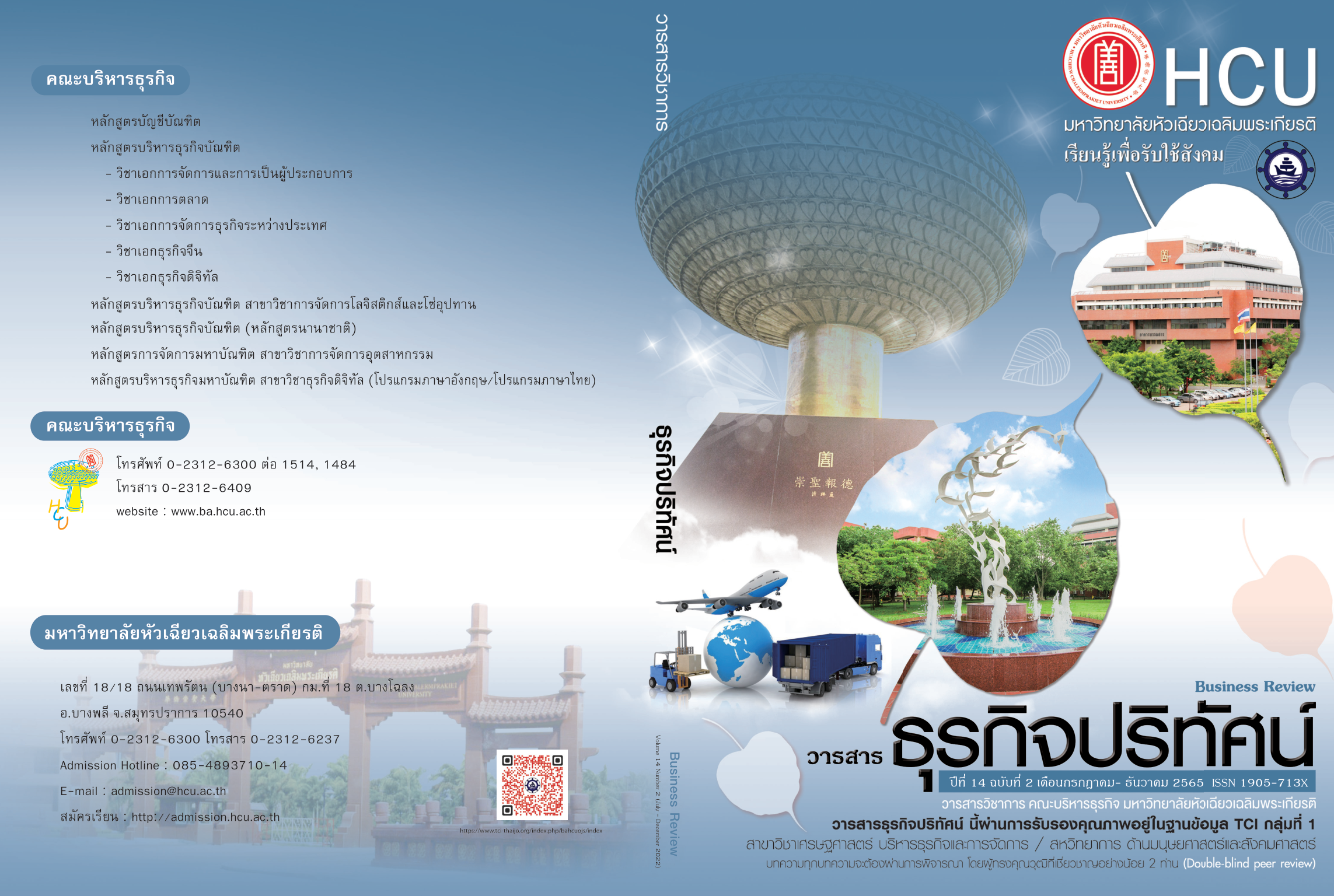The Relationship between Employer Brand Perception and Employee Performance with Job Satisfaction as a Mediating Variable : A Case Study of a Public Utility Enterprise in Thailand
Keywords:
Employer Brand Perception, Job Satisfaction, Employee PerformanceAbstract
This research aimed to 1) study the relationship between employer brand perception, job satisfaction and employee performance and 2) study the role of job satisfaction as a mediator of the relationship between employer brand perception and employee performance. The data were collected from 376 employees at a public utility enterprise in Thailand using a quota randomization method. The statistic applied to analyze the data were multiple regression and hierarchical multiple regression. The results of this study showed that 1) employer brand perception was positively related to employee performance 2) employer brand perception was positively related to job satisfaction 3) job satisfaction was positively related to employee performance and 4) job satisfaction partially mediated the relationship between employer brand perception and employee performance. The findings provide insight as to how an organization can establish and implement a concrete employer brand strategy to improve employee job satisfaction and performance.
References
กัลยา วานิชย์บัญชา. (2559). การวิเคราะห์สถิติ: สถิติสำหรับบริหารและวิจัย. พิมพ์ครั้งที่ 16. กรุงเทพฯ: โรงพิมพ์จุฬาลงกรณ์มหาวิทยาลัย.
เจษฎา นกน้อย. (2560). พฤติกรรมองค์การ. กรุงเทพฯ: สำนักพิมพ์แห่งจุฬาลงกรณ์มหาวิทยาลัย.
ธาดา ราชกิจ. (2562). การบริหารจัดการทรัพยากรมนุษย์ (Human Resource Management: HRM) หัวใจสำคัญของการขับเคลื่อนองค์กรยุคปัจจุบัน. สืบค้นเมื่อ 11 มีนาคม 2563, จาก hrnote.asia เว็บไซต์: https://th.hrnote.asia/orgdevelopment/th-whatishrm-190117/
นฤมล เพ็ชรทิพย์. (2559). จิตวิทยากับการทำงาน. ในคณะกรรมการกลุ่มผลิตชุดวิชาจิตวิทยาเพื่อการดำรงชีวิต (บก.), จิตวิทยาเพื่อการดำรงชีวิต. พิมพ์ครั้งที่ 1. กรุงเทพฯ: สำนักพิมพ์มหาวิทยาลัยสุโขทัยธรรมาธิราช.
บุญชัย วิรชัย และสมบูรณ์ สารพัด. (2562). ความสัมพันธ์เชิงสาเหตุของความพึงพอใจในงานและความผูกพันต่อองค์การที่มีต่อผลการปฏิบัติงานของพนักงานรัฐวิสาหกิจไฟฟ้าลาว. วารสารวิทยาลัยบัณฑิตศึกษาการจัดการ มหาวิทยาลัยขอนแก่น, 12(1), 40-62.
ปิลันธนา แป้นปลื้ม และวิโรจน์ เจษฎาลักษณ์. (2560). อิทธิพลของความยุติธรรมในองค์การต่อผลการปฏิบัติงานตามบทบาทหน้าที่ผ่านการรับรู้การสนับสนุนจากองค์การ. วารสารอิเล็กทรอนิกส์การเรียนรู้ทางไกลเชิงนวัตกรรม, 7(1), 55-67.
รุ่งโรจน์ อรรถานิทธิ์. (2554). Employee Engagement การสร้างความผูกพันของพนักงานในองค์กร. กรุงเทพฯ: บริษัท เอช อาร์ เซ็นเตอร์ จำกัด.
วัชระ เลิศพงษ์วรพันธ์ และพวงเพชร์ วัชรอยู่. (2558). ปัจจัยที่มีอิทธิพลต่อผลการปฏิบัติงานของพนักงานฝ่ายบริการบุคลากรของบริษัทสายการบินแห่งหนึ่ง. วารสารสังคมศาสตร์และมนุษยศาสตร์, 36(2), 74-86.
ศุภวัชร์ มาลานนท์. (2560). รัฐวิสาหกิจกับบรรษัทภิบาล (4) : บริษัทรัฐวิสาหกิจและการแข่งขันกับเอกชน. สืบค้นเมื่อ 23 มีนาคม 2563, จากข่าวหุ้นธุรกิจ เว็บไซต์: https://www.kaohoon.com/content/195478
สุวิมล ติรกานันท์. (2555). การวิเคราะห์ตัวแปรพหุในงานวิจัยทางสังคมศาสตร์. พิมพ์ครั้งที่ 2. กรุงเทพฯ: โรงพิมพ์แห่งจุฬาลงกรณ์มหาวิทยาลัย.
สุวิมล ติรกานันท์. (2557). ระเบียบวิธีการวิจัยทางสังคมศาสตร์: แนวทางสู่การปฏิบัติ. พิมพ์ครั้งที่ 12. กรุงเทพฯ: โรงพิมพ์แห่งจุฬาลงกรณ์มหาวิทยาลัย.
Ambler, T., & Barrow, S. (1996). The employer brand. Journal of brand management, 4(3), 185-206.
Babalola, S. S. (2016). The effect of leadership style, job satisfaction and employee-supervisor relationship on job performance and organizational commitment. Journal of Applied Business Research, 32(3), 935-946.
Backhaus, K., & Tikoo, S. (2004). Conceptualizing and researching employer branding. Career Development International, 9(5), 501-517.
Baron, R., & Kenny, D. (1986). The moderator-mediator variable distinction in social psychological research: Conceptual, strategic, and statistical considerations. Journal of Personality and Social Psychology, 51, 1173-1182.
Blau, P. M. (1986). Exchange and power in social life (2nd ed.). New York: Routledge.
Buyanjargal, B., & Sandagdorj, S. O. (2017). Employer Brand: The Relationship Among Perceived Employer Branding, Employee Performance and Retention in Mongolian Business Sector. International Journal of Management and Applied Science, 3(4), 30-36.
Cohen, J. (1988). Statistical power analysis for the behavioral sciences (2nd ed.). New York: Lawrence Erlbaum Associates.
Dögl, C., & Holtbrügge, D. (2014). Corporate environmental responsibility, employer reputation and employee commitment: An empirical study in developed and emerging economies. The International Journal of Human Resource Management, 25(12), 1739-1762.
Hackman, J. R., & Oldham, G. R. (1974). The Job Diagnostic Survey: An instrument for the diagnosis of jobs and the evaluation of job redesign projects. New Haven, Conn: Yale University.
Kaiser, M., & Regjepaj, A. (2019). Impact of Employer Branding on Employee Commitment and Satisfaction. Moderated by Generation X and Y. Master's Thesis, Kristianstad University.
Kendra, C. (2020). The Incentive Theory of Motivation. Retrieved March 30, 2020, from Verywellmind Website: https://www.verywellmind.com/the-incentive-theory-of-motivation-2795382
Koopmans, L., Bernaards, C., Hildebrandt, V., & De Vet, H. (2014). Improving the Individual Work Performance Questionnaire using Rasch Analysis. Journal of applied measurement, 15(2), 123-148.
Luthans, F., Luthans, B. C., & Luthans, K. W. (2015). Organizational Behavior: An Evidence-based Approach (13th ed.). Arizona: Information Age Publishing.
Maslow, A. H. (1943). A theory of human motivation. Psychological review, 50(4), 370–396.
Mosley, R. (2009). Employer Brand: The performance driver no business can ignore. London: Shoulders of Giants.
Robbins, S. P., & Judge, T. A. (2019). Organizational Behavior (18th ed.). London: Pearson.
SHRM. (2008). Staffing Research. The Employer Brand: A Strategic Tool to Attract, Recruit and Retain Talent. Retrieved February 11, 2020, from Docplayer Website: https://doc player.net/13725254-Staffing-research-the-employer-brand-a-strategic-tool-to-attract-recruit-and-retain-talent-published-by-the-society-for-human-resource-management.html
Sobel, M. E. (1982). Asymptotic confidence intervals for indirect effects in structural equation models. Sociological methodology, 13, 290-312.
Spence, M. (1973). Job Market Signaling. Quarterly Journal of Economics, 87(3), 355-374.
Springer, G. J. (2011). A study of job motivation, satisfaction, and performance among bank employees. Journal of Global Business, 5(1), 29-42.
Taj, S. A. (2016). Application of signaling theory in management research: Addressing major gaps in theory. European Management Journal, 34(4), 338-348.
Tanwar, K., & Prasad, A. (2016). The effect of employer brand dimensions on job satisfaction: gender as a moderator. Management Decision, 54(4), 854-886.
Tanwar, K., & Prasad, A. (2017). Employer brand scale development and validation: a second-order factor approach. Personnel Review, 46(2), 389-409.
Wong, H. C. Y. (2014). The influence of employer branding on employee performance. Ph.D. Thesis, University of Manchester.
Xia, H., & Yang, L. (2010). The Employer Branding and Employee Performance. Proceedings, 3rd International conference on information management, innovation management and industrial engineering, November 26-28, 2010 at Kunming. California: IEEE Computer Society Press.
Yalım, F., & Mızrak, K. C. (2017). A field study on the relationship between employer brand and employee satisfaction. International Review of Management and Marketing, 7(2), 92-103.
Downloads
Published
How to Cite
Issue
Section
License
Copyright (c) 2022 Business Review Journal

This work is licensed under a Creative Commons Attribution-NonCommercial-NoDerivatives 4.0 International License.
All articles published in the Business Administration and Management Journal Review are copyrighted by the journal.
The views and opinions expressed in each article are solely those of the individual authors and do not represent those of Huachiew Chalermprakiet University or any other faculty members. Each author is fully responsible for the content of their own article. Any errors or issues found are the sole responsibility of the respective author.




